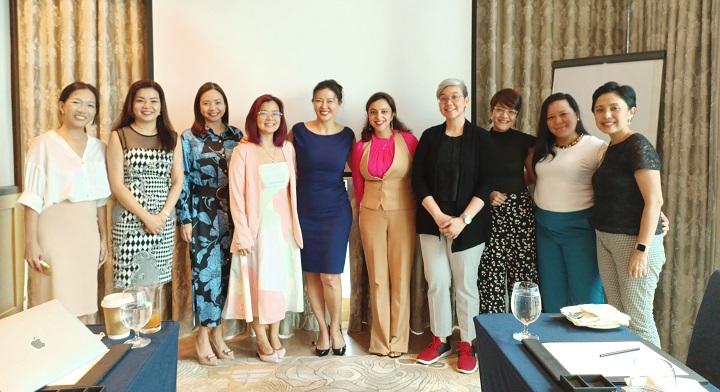- LinkedIn data shows the Philippines has made significant advancements in women’s representation in leadership roles, but more needs to be done to bridge the workplace gender gap
- Businesses need to embrace fair hiring & promotion opportunities based on skills & internal mobility practices
- Professionals need to grow their skills, connect with mentors, & adopt a growth mindset

During times of crisis and disruption, such as the ongoing pandemic and threats of a global economic slowdown, promoting workplace diversity may take a backseat. However, a recent roundtable between Feon Ang, Managing Director, Asia Pacific (APAC) at LinkedIn, and Filipina leaders and professionals highlighted that it is even more of a necessity.
“It’s a win-win situation – improving workplace diversity and gender parity throughout all levels of organizations, especially in leadership positions, not only levels the playing field for women but also works best for business outcomes,” said Ang, who met with women business leaders to exchange insights and ideas on bridging the gender gap in the Philippines and how LinkedIn, the world’s largest professional platform, can serve as a resource to do so.
“When businesses have people with varied strengths, backgrounds, and viewpoints, they are better able to cultivate the creativity, innovation, and resilience they need to survive and thrive,” she added. Recent McKinsey research also found that companies with diverse executive teams were 25% more likely to have above-average profitability.
In particular, the roundtable attendees noted that women business leaders often bring to the table qualities such as empathy, determination, and the ability to appreciate multiple perspectives, which can help organizations better weather such unprecedented times.
Addressing the gender gap in organizations
LinkedIn data published in the World Economic Forum’s 2022 Global Gender Gap Report found that the Philippines is ahead of its neighbors in the APAC in having the most significant increase in women in leadership roles. Only 1 in 3 (34%) hires into leadership positions in the Philippines in 2015 were women, which jumped to 43% in 2022. The Philippines ranks 4th worldwide in women’s representation in leadership positions. Of the APAC countries studied, the country also has the highest representation of women in leadership at 41%.
However, there is more work to be done. In the Philippines, women are not advancing into leadership roles as frequently as men, who are 26% more likely to be promoted.
In today’s shifting business landscape, Ang highlighted how leaders could bridge the gender gap by embracing a skills-first approach to hiring to ensure that female candidates with the right skills are equally considered for an open role. LinkedIn data revealed that employers who adopt a skills-first approach to hiring are 60% more likely to find a successful hire than those who don’t. It also helps with retention, as businesses that help employees develop new skills and grow in the company can retain employees for an average of 5.4 years, a significant increase from the average span of 2.9 years.
“It is critical to put together gender-neutral hiring panels and training for hiring managers and team leaders on removing biases and fair hiring practices that encourage flexibility,” Ang said. According to LinkedIn, over half of the women appreciate having flexibility at work because it would allow them to balance their careers and personal lives.
Rowena Zamora, GCash Chief Strategy Officer, agreed that flexibility is an enabler of gender equity. “I am privileged that my past and present organizations allowed me flexibility in work arrangements so I can be fulfilled not just at the workplace but also outside of it. I’ve realized that leadership is not about being overtly aggressive, it is also about graceful use of authority and being unapologetic about who you are.”
How women can uplift one another at work
While the roundtable discussed the steps organizations need to take to promote gender equity, the attendees also came together with ideas on what women need to do to advance and advocate for other women. They highlighted the importance of adopting a growth mindset and finding good mentors.
Kassy Braganza, a public speaker and coach, believes in learning new skills and finding role models. “I work with women who lost jobs during the pandemic and introduced to them how they can best leverage LinkedIn to get back on their feet. Because they invested in themselves and learned new skills, they are now earning better,” she said. Podcast owner Mae Cuison agreed on the value of mentors and encouraged all to reach out to people they admire to unlock learning opportunities. “Whenever I produce podcasts, I feel like I’m getting a VIP ticket to people’s minds and worlds, and I become empowered myself. Surround yourself with inspiring people you can grow with and learn from,” she said.
To that end, Mariel Tablan, an Associate Director and Head of Academy at AIA Philippines, encouraged embracing a growth mindset. “It’s about creating awareness about the opportunities available to women, empowering them to start something, explore, and thrive, despite uncertainties.”
Darlyn Ty-Nilo, President and Managing Director of Viviamo, Inc., said this growth journey could inspire others. “Seeing is believing. How will other women know what’s possible if you don’t share? In the Philippines, especially in barangays struggling in poverty, some young girls can only see themselves in low-paying jobs, no matter how brilliant and promising they are. By amplifying your story on LinkedIn, you encourage them to dream, cultivate self-efficacy, and inspire their passion for growth and overcoming challenges.”
LinkedIn is committed to helping women and every member of the global workforce connect to economic opportunities. “We need to work together to ensure that each member of the global workforce has equitable access to economic opportunities for a fairer and more inclusive society,” Ang said.

